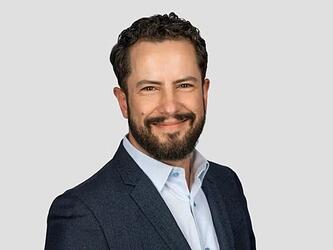Real men moisturise
Simon Duffy is wearing three days of facial hair when he meets me in a café/bar under Bulldog Skincare’s West London offices. But he is not sporting the stubble as a fashion statement; he’s grown it for research purposes.
“We’ve got some new shave prep products that we’re testing out,” he explains. “I’m waiting to test-drive them.”
Both Duffy’s hands-on approach and Bulldog’s modest premises are an apt introduction to the male skincare company that Duffy and his friend and business partner Rhodri Ferrier founded in 2006. Bulldog, as Duffy describes it, is a down-to-earth brand for the man who “is not super-ripped, not David Beckham, not a gorgeous guy, and who’s probably a little bit overweight”.
Bulldog’s launch timing was unfortunate: it went to market in 2007, just a year before the collapse of the global economy. But its ambitions were large with a proposition that sought to revolutionise the men’s facial skincare market with naturally-formulated products for men. It was unusual in a market that was dominated by brands that were either an extension of a primarily female skincare brand, like Nivea Men or L’Oreal Men Expert, or which adopted an overtly macho tone, such as Gillette or Lynx.
Challenging big brands
Today Bulldog is a lean, mean fighting machine with listings in 12,000 stores, across 12 countries, giving established FMCG and cosmetics giants Procter & Gamble, Unilever, Beiersdorf and L’Oreal a run for their money in the burgeoning men’s skincare sector.
Taking on the big boys meant that Bulldog was often dubbed a challenger brand; and on the surface it still is, with a small eight-strong team and a nimble culture.
But Duffy stresses that factors such as the brand’s market share, its forecast £9m in sales in 2015 (see box) and driving growth in a generally flat UK men’s facial skincare category mean that the start-up label no longer sticks.
“We’ve moved on to the next level,” he says. “We’re bigger than Unilever’s Dove brand in the men’s skincare category [IRI data] and we’ve survived Procter & Gamble launching Gillette Skincare in the UK, so we’ve seen off some big heavyweight competitors.”
But while Bulldog may be performing strongly in sales against the FMCG and cosmetics behemoths, it cannot enjoy nearly the same levels of marketing and research investment of its big-budget rivals. Accordingly, Duffy’s attitude to market research in shaping and driving his business reflects Bulldog’s modest size and small coffers.
Research approach
“We’re not a massive company underpinned by thorough research because we have to cut our cloth according to the state of our business,” he explains. “We’re doing much more at the moment, but at the beginning it was more instinctive.”
Yet Duffy himself is no stranger to using data and research. Before he and Ferrier launched Bulldog, he worked at advertising agency Saatchi & Saatchi, and one of its spin-off agencies specialising in product innovation, Fahrenheit 212. Working with clients including Diageo meant that Duffy had access to vast amounts of market research to inform product innovations.
But conversely, Bulldog was founded, not on the basis of sturdy research that identified a market rich in pickings, but on a personal insight, an intuitive “light-bulb moment” that occurred in New York nearly a decade ago.
“The idea for Bulldog came when I was shopping for naturally formulated skincare products for my girlfriend Annabel, who is now my wife,” Duffy says. “I used to have to go to Whole Foods, which is this phenomenal retailer which specialises in organic food and has a thriving natural and organic health and beauty sector.”
Whole Foods sold skincare products that used natural, organic ingredients that were paraben- and chemical-free and adhered to stringent guidelines.
“I was trying to get stuff for Annabel, thinking I would get some for myself, but there was just nothing there for men. That was a light-bulb moment, if that exists. Rhodri [Ferrier] and I were looking for a business idea at the time and I wanted to create a brand, something physical that I could walk into a store and see.
Mind the gap
“You think that’s the gap in the market but then you have to figure out – is there a market in the gap? Can you make a business out of this? Why is no one else doing this so far? If you did do this, would anyone buy it?”
One could argue it would be pretty hard to answer these questions without the benefit of some good market research, so how could he know there was a market out there?
“The flat answer is that you don’t know. It wasn’t something that we felt that we could research ourselves to satisfactory confidence. So it was a big risk when we did it. It was a product that was named and formulated unlike any other.
“We were really solving a problem for ourselves, as outsiders to the industry frustrated by the current choices that were out there. I didn’t feel I wanted to spend £30 on a moisturiser in a department store. I didn’t feel that L’Oreal was a brand designed for me, as it’s so obviously female. I wanted natural ingredients as all the brands have such commoditised, conventional formulations, with parabens etc. We were really creating the products for ourselves,” explains Duffy.
One of the toughest parts of launching a product of this type is securing those all-important listings. Persistence, lots of cold calls, a big dose of luck and a retailer that ultimately “shared our vision” resulted in an exclusive deal with Sainsbury’s.
In June 2007, Bulldog launched nationwide on the shelves of the supermarket. The following year saw the brand double its range with Sainsbury’s from six to 12 products, while the end to the exclusivity deal meant that it rolled out in Waitrose, Tesco and, eventually, Boots.
Growing sales
Today, Bulldog sells via retailers including Ocado, Planet Organic, Superdrug and, with pleasing symmetry, where Duffy was inspiration-struck – at Whole Foods Market. The company has also expanded overseas, and can be found in Norway, Sweden, Germany, the US, Ireland, Austria, Australia and New Zealand.
Bulldog’s Original Moisturiser is still the company’s biggest seller, commanding around a 15% share of the UK male moisturiser market, outperforming Gillette’s skincare products and Dove Men+Care, making it the third biggest brand behind L’Oreal Men Expert and Nivea Men.
It is also the fastest growing brand in the men’s facial skincare segment, growing in value by 44.7% in the half-year to 13 September (AC Nielsen), outperforming a market decline of 1.4%. The only other brand to grow in value in the period was L’Oreal Men Expert which was up a marginal 0.8%.
Duffy attributes much of Bulldog’s successful growth not just to eating into the shares of its bigger rivals, but growing the category itself. And there is still a huge untapped audience of men out there, he insists. Currently between 20% and 25% of men regularly moisturise, compared with around 90% of women. While clearly the gender gulf will always be wide, there is room for growth, he says.
Who is Bulldog’s target market?
“The purchase data would suggest it’s quite a broad church, across various ages and geographies,” Duffy explains. “There’s a dynamic within the whole category that means that at most of our retailers, our products are most likely to be bought by a wife or a mother or a girlfriend than by an end-user.
“If that’s the volume target, when we designed the brand, the brand target would be male, urban, professional, university-educated, probably in the early stages of his career.”
“We fundamentally believe that the best brands have to be close to their consumers,” Duffy says. “So we’re very conscious of staying in the loop about what people think of our brand. But whether that comes to us through paid-for research is a separate discussion.”
That’s not to say Bulldog is anti-research, more that budgetary constraints necessitate greater discretion. “The trick with research is that there’s lots of stuff that’s nice to know,” he says. “But, what you really want, is to focus your research so that it’s actually going to help you make a decision that impacts your business.”
So, Bulldog commissions qualitative research with panel groups, usually conducted around key decisions. “For example, we changed our packaging a few times – it’s been through three key iterations,” Duffy says.
The most recent brand overhaul kicked off in 2009, when Bulldog worked with Razor Research and branding agency B&B Studios. Razor conducted various qualitative studies that informed the brand’s third iteration in 2011 after research found that the bulldog was “barking too loudly, so we softened our logo a bit”.
From an ongoing research perspective, the marketing team runs periodic brand internet surveys to check on progress, supplied by ICM.
The firm is currently engaged in a data-sharing exercise with one of its biggest retail partners. “We’re doing something at the moment with Boots where we’re looking at quite a big bit of work to try to understand more about trends within the male grooming category and specifically the role that Bulldog is playing,” he says.
“But we don’t have the results yet, it’s something that’s ongoing. It will give us access to more insight than we’ve had before.”

We hope you enjoyed this article.
Research Live is published by MRS.
The Market Research Society (MRS) exists to promote and protect the research sector, showcasing how research delivers impact for businesses and government.
Members of MRS enjoy many benefits including tailoured policy guidance, discounts on training and conferences, and access to member-only content.
For example, there's an archive of winning case studies from over a decade of MRS Awards.
Find out more about the benefits of joining MRS here.














0 Comments